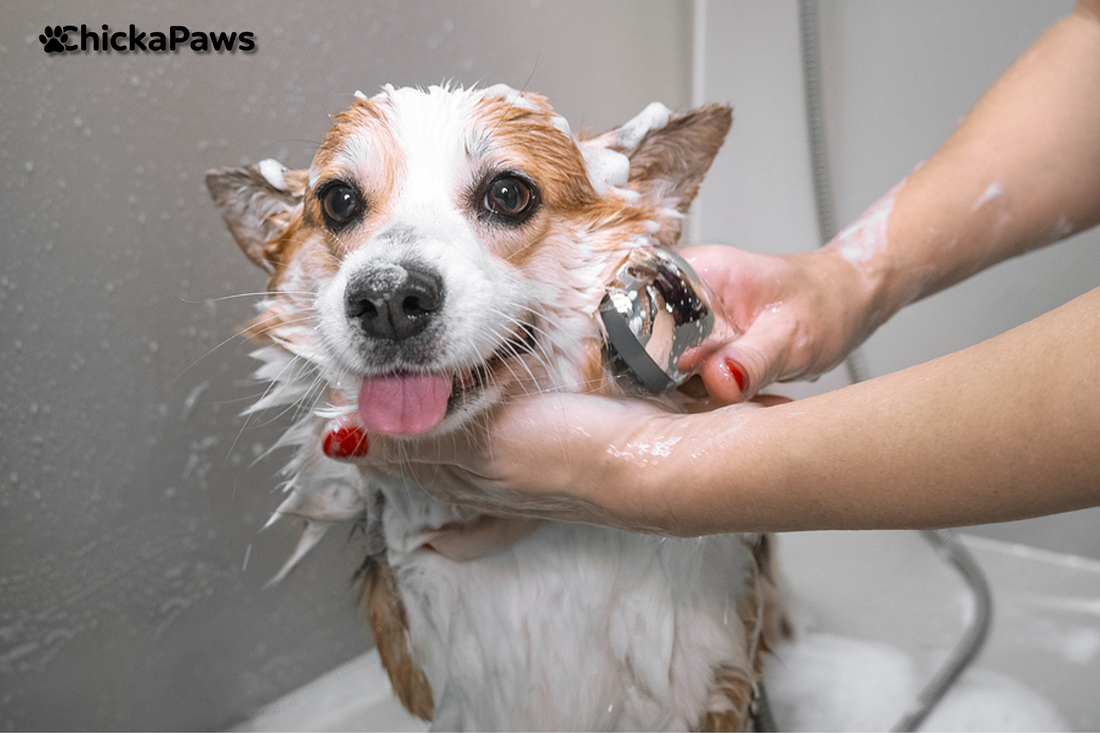
🐾How to Bathe a Dog That’s Afraid of Water — Step-by-Step with Love and Patience
Share
Every dog parent knows that look — those big, pleading eyes that say, “Please, not the bath.”
For many pups, bath time isn’t about getting clean. It’s about fear — the sound of rushing water, the slippery floor, or the strange smell of shampoo.
But here’s the truth: bathing your dog doesn’t have to be stressful. With empathy, patience, and the right approach, you can turn this challenge into a moment of trust and bonding that your dog actually enjoys.
This guide will show you exactly how — backed by real behavioral insights and positive reinforcement techniques used by professional trainers.
💧 Why Dogs Fear Water
 Before you can fix the fear, you need to understand it.
Before you can fix the fear, you need to understand it.
Dogs aren’t born afraid of water — they learn fear from experience.
Here are the most common triggers:
- Loud noises: The sound of running water can feel overwhelming to sensitive dogs.
- Slippery surfaces: Losing balance once can create lasting fear.
- Negative association: If a bath once involved shouting or cold water, they’ll remember.
- Lack of control: Being held still in a strange place makes some dogs panic.
👉 Pro Tip: Build positive associations first. Let your dog explore the bathroom or tub without water. Toss treats, praise them, and make the space safe again.
🐕 Step-by-Step Guide: Turning Fear Into Comfort
This process takes patience — but each step helps rebuild confidence and connection.
 1. Set the Mood First
1. Set the Mood First
Turn bath time into a calm experience.
Use gentle lighting, soft music, and a quiet environment. Your tone should be slow, kind, and reassuring. Dogs mirror your emotions — if you’re calm, they’ll be calm.
“The calmer your energy, the more your dog will trust your hands.” — Dog Behaviorist Principle, ASPCA
2. Prepare Everything Before You Start
Have towels, shampoo, and treats ready. Avoid stopping mid-bath to find supplies — it breaks focus and increases anxiety.
Add a non-slip mat to help your dog feel grounded and secure.
3. Start Without Water
Take baby steps. Use a damp cloth to wipe your dog’s fur the first few times. Reward them for staying calm.
Once they’re used to the cloth, slowly introduce lukewarm water near their paws — never pour directly on the head or back at first.
👉 Behavioral trick: Use high-value treats (like small pieces of boiled chicken) only during bath time. Your dog will begin to associate bathing with rewards.
4. Use the Right Tools
Choose a dog-specific shampoo — preferably one with natural ingredients like oatmeal or chamomile.
Avoid human shampoos — they can irritate a dog’s skin and strip natural oils.
If your dog still resists, try a handheld sprayer with a low setting or a cup to control water flow. Gentle water pressure reduces fear.
5. Reward Every Success
Each small win deserves praise.
Your dog stepped into the tub? Treat. Stayed calm during rinsing? Treat again.
This builds positive repetition, turning fear into familiarity.
“Dogs learn through consistency and affection, not force.” — American Kennel Club Training Manual
6. Dry with Love
When you finish, wrap your dog in a warm towel and speak softly.
Some dogs fear dryers because of the noise, so let them air-dry if possible — or use a pet dryer on a low, quiet setting.
👉 Pro Tip: End with cuddles, playtime, or a short walk. Reinforce that bath time means joy, not stress.
🌿 Gentle Add-Ons for Anxious Dogs

If your dog’s anxiety runs deep, try these:
-
Lavender aromatherapy: Dog-safe calming scents help ease nerves.
-
Slow introduction: Break the bath into short sessions (2–3 minutes at first).
- Calming playlists: “Through a Dog’s Ear” (available on Spotify) has been clinically proven to reduce stress in dogs.
❤️ Bath Time = Bond Time
 Bathing your dog isn’t just about hygiene — it’s a ritual of care and trust.
Bathing your dog isn’t just about hygiene — it’s a ritual of care and trust.
Each time you stay patient, speak gently, and guide them with kindness, you’re telling them: “You’re safe. You’re loved.”
And when your dog finally stands calmly in the tub, tail wagging instead of trembling — that’s more than progress. That’s a shared victory.
Because clean fur is nice…
But a confident, trusting dog is the true reward.
